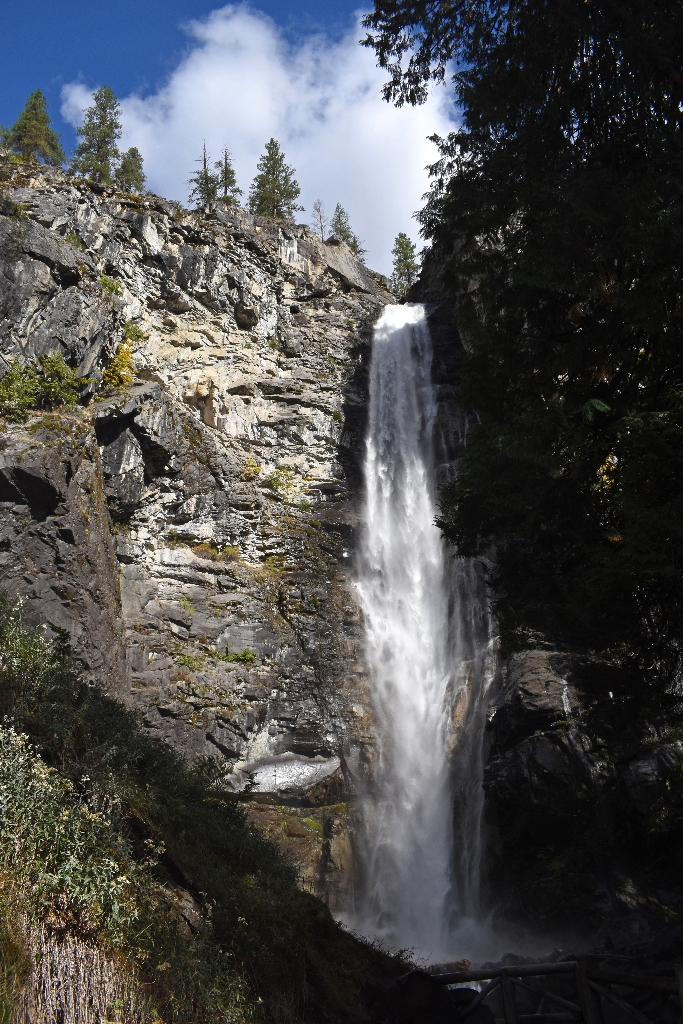
Rainbow Falls drops 312 feet in the Stehekin Valley and the spray creates a rainbow on sunny days. Flowing year-round from its headwaters near McAlester Mountain and Dee Dee Lakes, the falls is largest during spring runoff, usually in May and June. Both a lower and upper viewpoint are a short walk from the parking lot. The lower viewpoint is wheelchair accessible.
What had to happen for Rainbow Falls to roar down into Stehekin Valley? The answer lies in the different types of glaciers that carved these mountains and what was left behind.
Taking turns during great ice ages during the past 2.6 million years, ice from both a massive continental glaciers stretching from an ice sheet in Canada and from smaller local valley glaciers shaped the mountains, valleys, and what became Lake Chelan. The ice from the continental ice sheet entered Stehekin Valley by flowing down through Rainbow Creek Valley above you. This massive ice sheet in Stehekin Valley cut more deeply than glaciers in smaller tributaries and as a result, tributaries like Rainbow Creek were left as hanging valleys.
As the ice melted away, ancient Rainbow Creek became blocked by massive leftover boulders and gravel from the lobe of the continental ice sheet. The creek blindly cut through the rubble before it tumbled over the edge of a hanging valley to free fall to the Stehekin Valley floor, creating the waterfall we see today.
What had to happen for Rainbow Falls to roar down into Stehekin Valley? The answer lies in the different types of glaciers that carved these mountains and what was left behind.
Taking turns during great ice ages during the past 2.6 million years, ice from both a massive continental glaciers stretching from an ice sheet in Canada and from smaller local valley glaciers shaped the mountains, valleys, and what became Lake Chelan. The ice from the continental ice sheet entered Stehekin Valley by flowing down through Rainbow Creek Valley above you. This massive ice sheet in Stehekin Valley cut more deeply than glaciers in smaller tributaries and as a result, tributaries like Rainbow Creek were left as hanging valleys.
As the ice melted away, ancient Rainbow Creek became blocked by massive leftover boulders and gravel from the lobe of the continental ice sheet. The creek blindly cut through the rubble before it tumbled over the edge of a hanging valley to free fall to the Stehekin Valley floor, creating the waterfall we see today.
Is there something we missed for this itinerary?
Itineraries across USA

Acadia

Arches National Park

Badlands

Big Bend

Biscayne

Black Canyon Of The Gunnison

Bryce Canyon

Canyonlands

Capitol Reef

Carlsbad Caverns

Channel Islands

Congaree

Crater Lake

Cuyahoga Valley

Death Valley

Dry Tortugas

Everglades

Gateway Arch

Glacier

Grand Canyon

Grand Teton

Great Basin

Great Smoky Mountains

Guadalupe Mountains

Haleakalā

Hawaiʻi Volcanoes

Hot Springs

Indiana Dunes

Isle Royale

Joshua Tree

Kenai Fjords

Kobuk Valley

Lassen Volcanic

Mammoth Cave

Mesa Verde

Mount Rainier

North Cascades

Olympic

Petrified Forest

Pinnacles

Rocky Mountain

Saguaro

Shenandoah

Theodore Roosevelt

Virgin Islands

Voyageurs

White Sands

Wind Cave

Yellowstone

Yosemite

Zion